Abstract
From echocardiographic measurements, 39 patients with established, uncomplicated primary hypertension (diastolic pressure > 100 mmHg) were classified as follows: normal-sized heart (group 1, 10 cases); concentric left ventricular hypertrophy (group 2, 18 cases); left ventricular hypertrophy and cavity enlargement (group 3, 11 cases). Eighteen age-matched healthy subjects were investigated as a control group. Systolic and diastolic arterial pressure increased progressively from group 1 to 2 to 3. Left ventricular function, assessed from the relation between diastolic diameter and stroke index, was maintained in group 1, increased in group 2 (in spite of the greater pressure load), and reduced in group 3, in comparison with controls. Similarly, the mean velocity of circumferential fibre shortening (VCF) was normal in group 1, significantly increased in group 2, and reduced in group 3. It was impossible to discern whether the different behaviour of VCF in group 2 and in group 3 reflected opposite changes in ventricular contractility, or in wall stress during ejection, or in both. At variance with previous conclusions (which were based on utilisation of electrocardiographic and chest x-ray criteria to define hypertrophy) it is suggested that left ventricular concentric hypertrophy in man consequent to sustained hypertension is associated with an improved function. Whether this feature depends upon an augmented contractility or a ventricular unloading effect related to hypertrophy remains uncertain.
Full text
PDF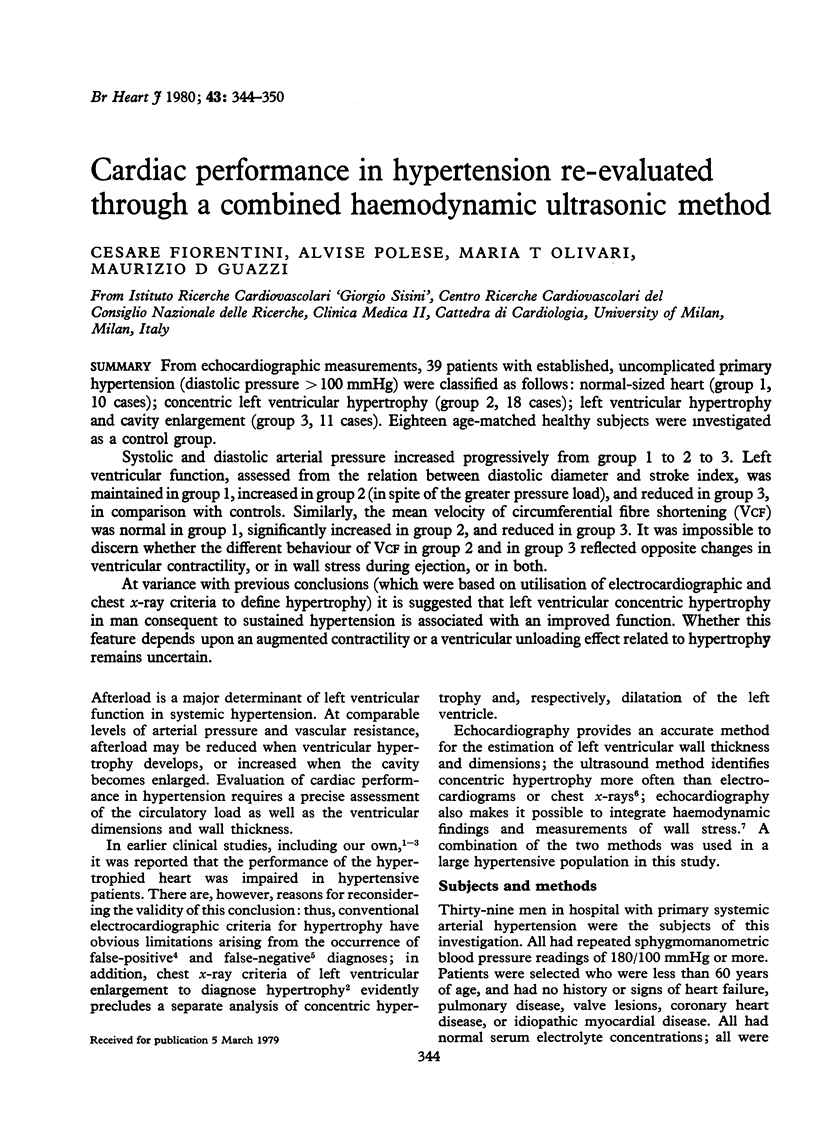
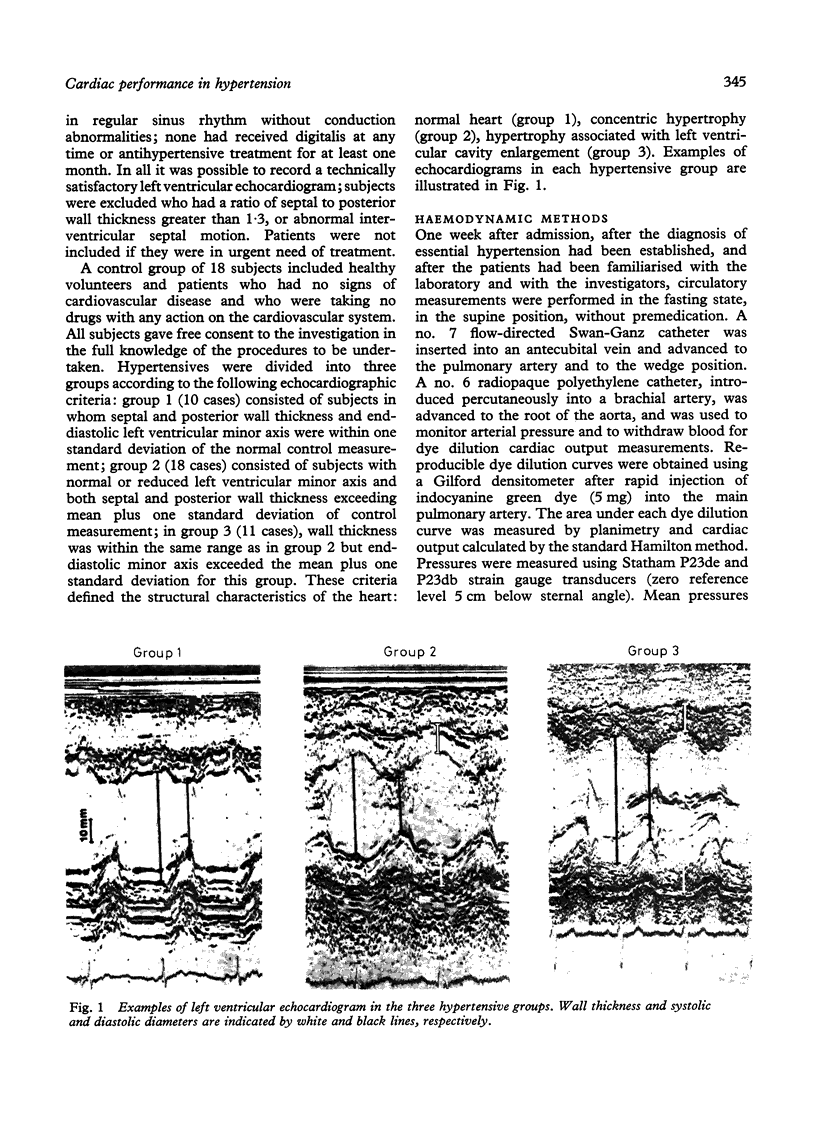
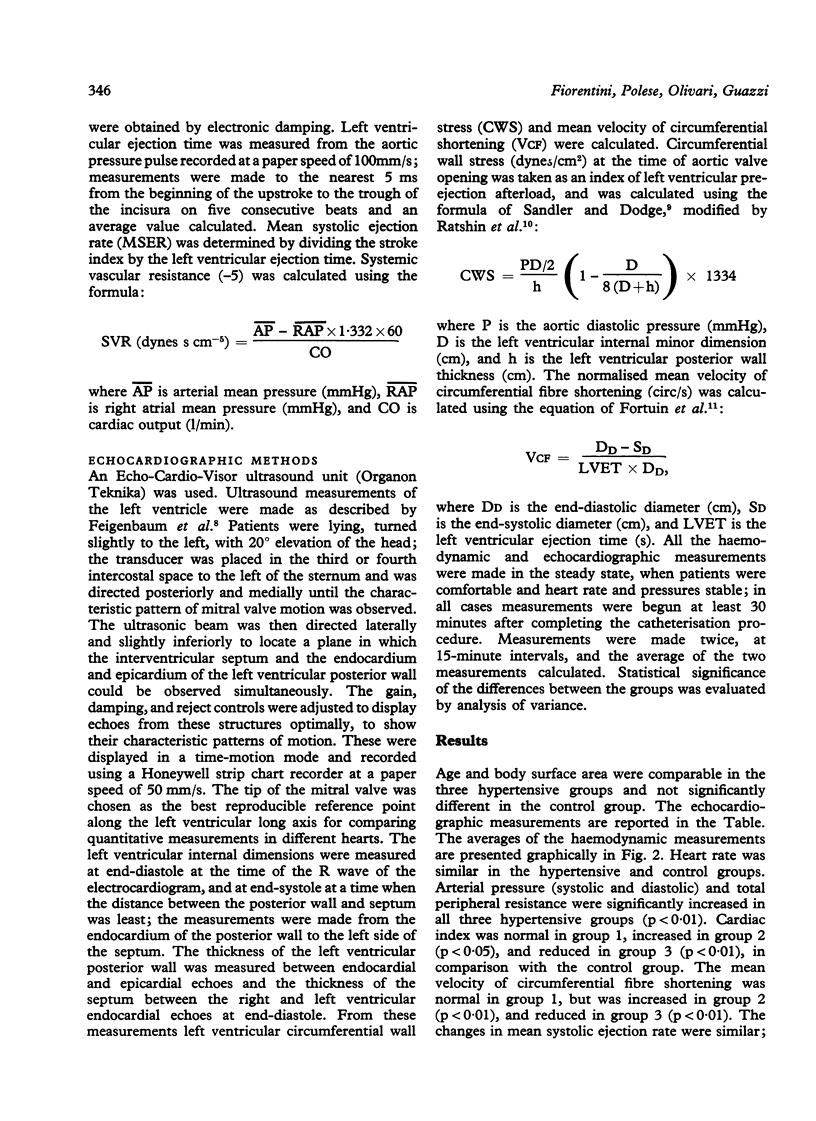
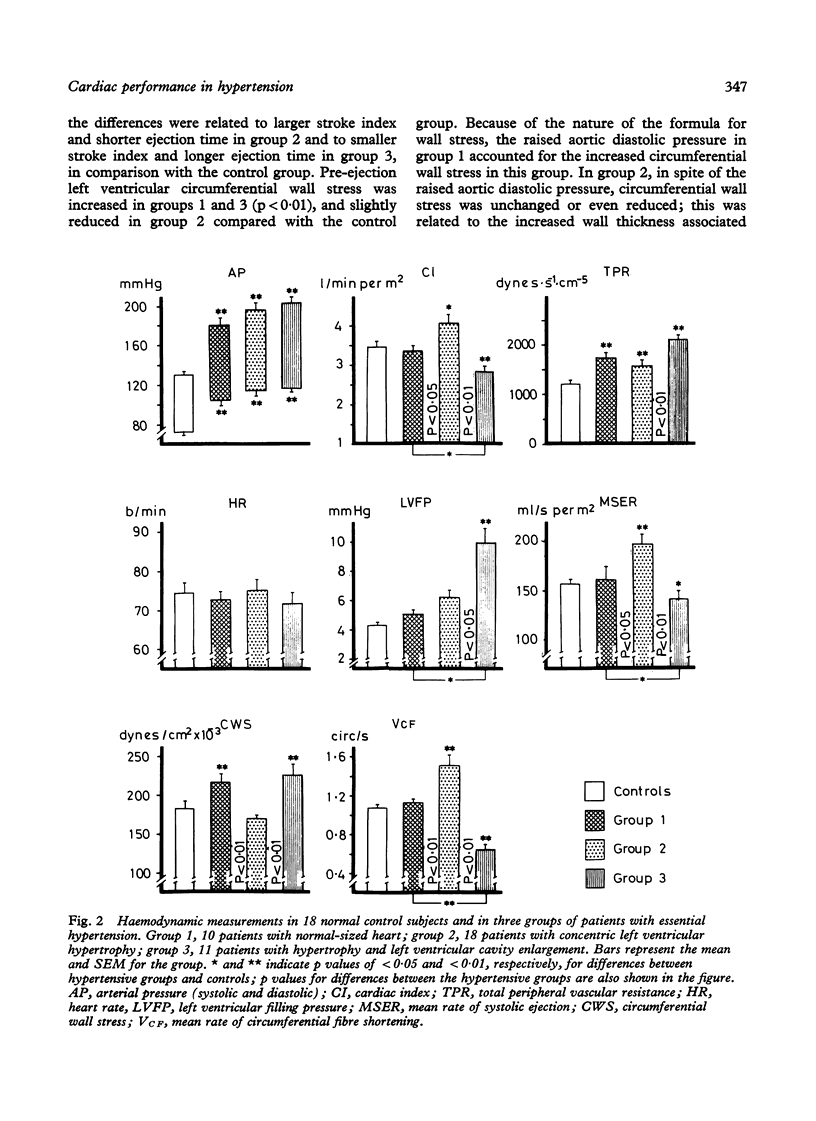
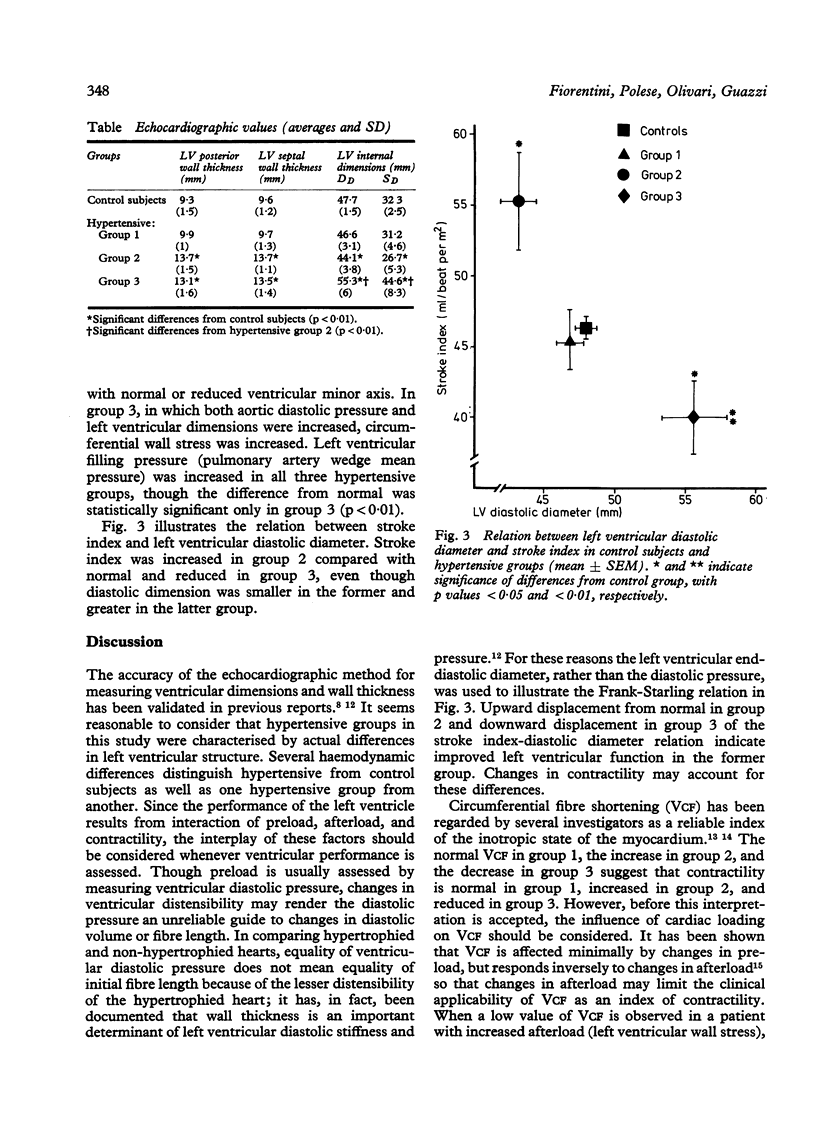
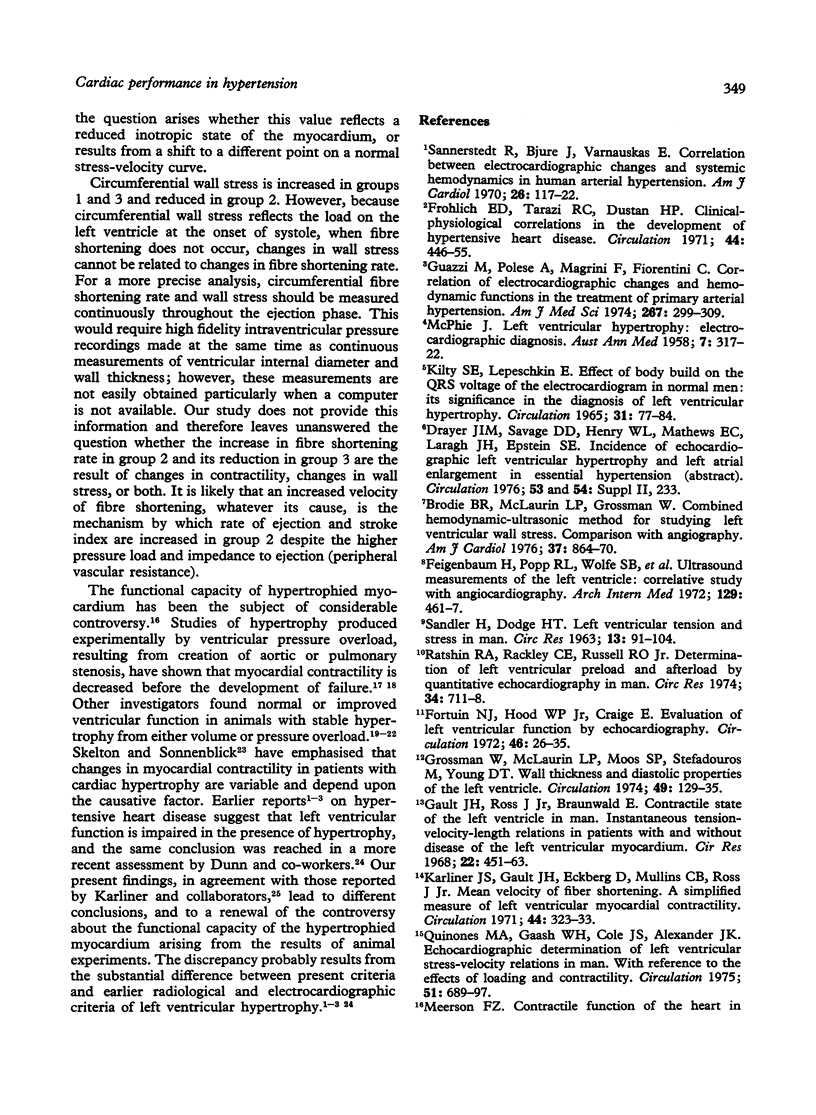
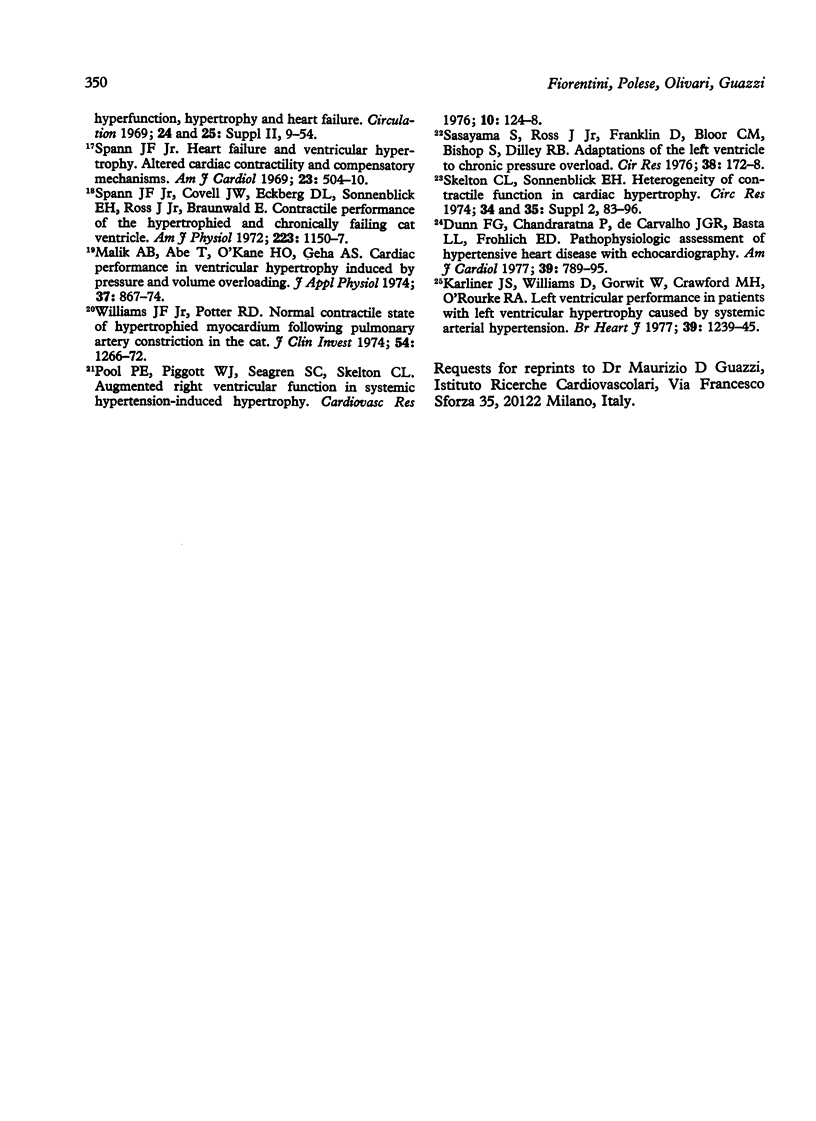
Images in this article
Selected References
These references are in PubMed. This may not be the complete list of references from this article.
- Brodie B. R., McLaurin L. P., Grossman W. Combined hemodynamic-ultrasonic method for studying left ventricular wall stress: comparison with angiography. Am J Cardiol. 1976 May;37(6):864–870. doi: 10.1016/0002-9149(76)90111-9. [DOI] [PubMed] [Google Scholar]
- Dunn F. G., Chandraratna P., deCarvalho J. G., Basta L. L., Frohlich E. D. Pathophysiologic assessment of hypertensive heart disease with echocardiography. Am J Cardiol. 1977 May 26;39(6):789–795. doi: 10.1016/s0002-9149(77)80028-3. [DOI] [PubMed] [Google Scholar]
- Feigenbaum H., Popp R. L., Wolfe S. B., Troy B. L., Pombo J. F., Haine C. L., Dodge H. T. Ultrasound measurements of the left ventricle. A correlative study with angiocardiography. Arch Intern Med. 1972 Mar;129(3):461–467. [PubMed] [Google Scholar]
- Fortuin N. J., Hood W. P., Jr, Craige E. Evaluation of left ventricular function by echocardiography. Circulation. 1972 Jul;46(1):26–35. doi: 10.1161/01.cir.46.1.26. [DOI] [PubMed] [Google Scholar]
- Frohlich E. D., Tarazi R. C., Dustan H. P. Clinical-physiological correlations in the development of hypertensive heart disease. Circulation. 1971 Sep;44(3):446–455. doi: 10.1161/01.cir.44.3.446. [DOI] [PubMed] [Google Scholar]
- Gault J. H., Ross J., Jr, Braunwald E. Contractile state of the left ventricle in man: instantaneous tension-velocity-length relations in patients with and without disease of the left ventricular myocardium. Circ Res. 1968 Apr;22(4):451–463. doi: 10.1161/01.res.22.4.451. [DOI] [PubMed] [Google Scholar]
- Grossman W., McLaurin L. P., Moos S. P., Stefadouros M., Young D. T. Wall thickness and diastolic properties of the left ventricle. Circulation. 1974 Jan;49(1):129–135. doi: 10.1161/01.cir.49.1.129. [DOI] [PubMed] [Google Scholar]
- Guazzi M., Polese A., Magrini F., Fiorentini C. Correlation of electrocardiographic changes and hemodynamic functions in the treatment of primary arterial hypertension. Am J Med Sci. 1974 May;267(5):299–309. doi: 10.1097/00000441-197405000-00006. [DOI] [PubMed] [Google Scholar]
- KILTY S. E., LEPESCHKIN E. EFFECT OF BODY BUILD ON THE QRS VOLTAGE OF THE ELECTROCARDIOGRAM IN NORMAL MEN: ITS SIGNIFICANCE IN THE DIAGNOSIS OF LEFT VENTRICULAR HYPERTROPHY. Circulation. 1965 Jan;31:77–84. doi: 10.1161/01.cir.31.1.77. [DOI] [PubMed] [Google Scholar]
- Karliner J. S., Gault J. H., Eckberg D., Mullins C. B., Ross J., Jr Mean velocity of fiber shortening. A simplified measure of left ventricular myocardial contractility. Circulation. 1971 Sep;44(3):323–333. doi: 10.1161/01.cir.44.3.323. [DOI] [PubMed] [Google Scholar]
- Karlinger J. S., Williams D., Gorwit J., Crawford M. H., O'Rourke R. A. Left ventricular performance in patients with left ventricular hypertrophy caused by systemic arterial hypertension. Br Heart J. 1977 Nov;39(11):1239–1245. doi: 10.1136/hrt.39.11.1239. [DOI] [PMC free article] [PubMed] [Google Scholar]
- Malik A. B., Abe T., O'Kane H. O., Geha A. S. Cardiac performance in ventricular hypertrophy induced by pressure and volume overloading. J Appl Physiol. 1974 Dec;37(6):867–874. doi: 10.1152/jappl.1974.37.6.867. [DOI] [PubMed] [Google Scholar]
- McPHIE J. Left ventricular hypertrophy: electrocardiographic diagnosis. Australas Ann Med. 1958 Nov;7(4):317–327. doi: 10.1111/imj.1958.7.4.317. [DOI] [PubMed] [Google Scholar]
- Pool P. E., Piggott W. J., Seagren S. C., Skelton C. L. Augmented right ventricular function in systemic hypertension-induced hypertrophy. Cardiovasc Res. 1976 Jan;10(1):124–128. doi: 10.1093/cvr/10.1.124. [DOI] [PubMed] [Google Scholar]
- Quinones M. A., Gaasch W. H., Cole J. S., Alexander J. K. Echocardiographic determination of left ventricular stress-velocity relations. Circulation. 1975 Apr;51(4):689–700. doi: 10.1161/01.cir.51.4.689. [DOI] [PubMed] [Google Scholar]
- Ratshin R. A., Rackley C. E., Russell R. O., Jr Determination of left ventricular preload and afterload by quantitative echocardiography in man. Circ Res. 1974 May;34(5):711–718. doi: 10.1161/01.res.34.5.711. [DOI] [PubMed] [Google Scholar]
- SANDLER H., DODGE H. T. LEFT VENTRICULAR TENSION AND STRESS IN MAN. Circ Res. 1963 Aug;13:91–104. doi: 10.1161/01.res.13.2.91. [DOI] [PubMed] [Google Scholar]
- Sannerstedt R., Bjure J., Varnauskas E. Correlation between electrocardiographic changes and systemic hemodynamics in human arterial hypertension. Am J Cardiol. 1970 Aug;26(2):117–122. doi: 10.1016/0002-9149(70)90768-x. [DOI] [PubMed] [Google Scholar]
- Sasayama S., Ross J., Jr, Franklin D., Bloor C. M., Bishop S., Dilley R. B. Adaptations of the left ventricle to chronic pressure overload. Circ Res. 1976 Mar;38(3):172–178. doi: 10.1161/01.res.38.3.172. [DOI] [PubMed] [Google Scholar]
- Spann J. F., Jr, Covell J. W., Eckberg D. L., Sonnenblick E. H., Ross J., Jr, Braunwald E. Contractile performance of the hypertrophied and chronically failing cat ventricle. Am J Physiol. 1972 Nov;223(5):1150–1157. doi: 10.1152/ajplegacy.1972.223.5.1150. [DOI] [PubMed] [Google Scholar]
- Spann J. F., Jr Heart failure and ventricular hypertrophy. Altered cardiac contractility and compensatory mechanisms. Am J Cardiol. 1969 Apr;23(4):504–510. doi: 10.1016/0002-9149(69)90003-4. [DOI] [PubMed] [Google Scholar]
- Williams J. F., Jr, Potter R. D. Normal contractile state of hypertrophied myocardium after pulmonary artery constriction in the cat. J Clin Invest. 1974 Dec;54(6):1266–1272. doi: 10.1172/JCI107871. [DOI] [PMC free article] [PubMed] [Google Scholar]



